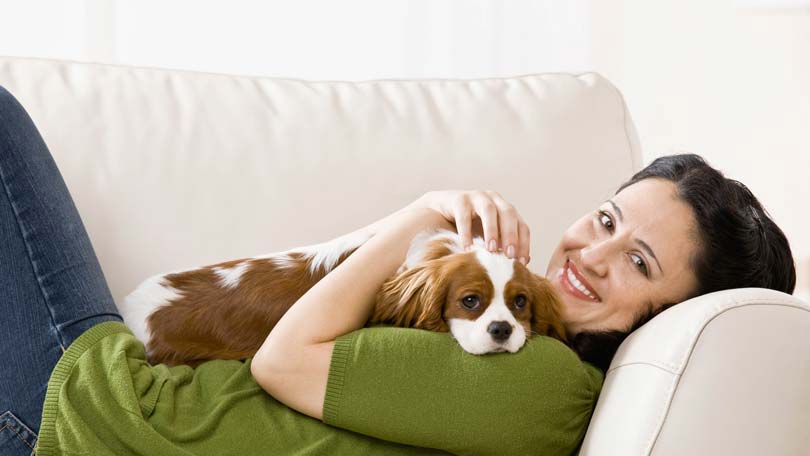
A true toy spaniel this is a dynamic small breed that is bigger in personality than their size. For people who are renting and need a dog that is under a weight limit, this is a pretty dog that is 13-18 pounds and 12-13 inches tall. The Cavalier King Charles Spaniel is a mix of heritage – that of a house dog and that as a spaniel. The two traits combine for a loving, active but easily cared for dog that adapts to many situations if we consider that heritage.
While there are individuals that vary it’s important to remember that, as a spaniel, they have an active working heritage. Officially they come in four colors – red and white, tricolor, ruby and black and tan. The ruby is a solid red while the black and tan has a “Doberman paint job” – both of these have no white on them.
Dating back to the early 1600s this is a breed that, although bred as a house pet, has the spaniel exuberance for chasing what moves. It is said they were bred down from hunting spaniels to produce a toy dog recorded at the time of England’s Charles II. It’s said when the house of Stuart fell the breed became extremely rare, with the Tudors favoring the Pug. Political ties nearly became the end of the breed, before Queen Victoria brought some back, although changed from their earlier form.
Due to this background this is not a breed that is happy being an outdoor kennel dog. They are a “people dog” and want to be where people are, even more than some other breeds.
The spaniel sporting dog also brings in a normally great temperament, ease of training and generally get along well with other dogs. They are smart little dogs and, like many intelligent dogs, this can lead to some creative entertainment without consistent guidance and training.
They are happiest with regular exercise and although they have a long coat it’s silky so that regular brushing will keep it in condition. From a training standpoint the spaniel heritage can lend itself to chasing anything that moves. Never leave your Cavalier King Charles Spaniel loose – they do not recognize boundaries and can too easily get in trouble following something fun.
There are some health issues to watch for and among them is Mitral Valve Disease or MVD. This is a disease of a part of the heart and leads to congestive heart failure and there is no treatment. Testing of parents is very important. Although many toy breeds are affected by this, it strikes particularly early and hard, with faster progression than other breeds.
Maintaining MVD means paying special attention to small things, regular heart checks and teeth care. Poor teeth can lead to infection and other problems, and a dog that already has heart issues is one that doesn’t need to fight off something that can be prevented. Keep them at a healthy weight, and carefully balance exercise with overstressing the dog’s heart and system. There is medication to help and careful monitoring of the disease is needed to maximize what time you have left. Dogs can and have lived to 8-10 years old with proper care, but there is little question that it shaves precious years from their lives.
There is some concern with luxating patella, a disease that the knee is unstable which causes lameness, but choosing dogs with good bone and healthy parents reduces the chances of having to deal with this.
There are a few eye diseases that can affect Cavalier King Charles Spaniels and testing for these is recommended especially if you are breeding. Cataracts, retinal dysplasia and cherry eye can all be conditions that can cause problems.
An inherited condition called Syringomyelia is a progressive neurological disease that affects Cavaliers at a higher number than other breeds. It can be found in all colors, lines and both sexes and usually appears between 6 months and 3 years but can be as late as 10. The disease begins when there is not enough room in the skull for the back side of the brain, which means the fluid surrounding the brain is forced though a smaller than normal opening to the spinal cord. A major sign is scratching the neck. Unfortunately this can also be diagnosed (or misdiagnosed) as allergies, fleas, skin irritations and other things. The key here is excessive – especially when excited or on the lead, sometimes scratching the air. Some dogs whine or yelp for no reason and sometimes there is weakness, lack of coordination or lameness, or obsessive licking of the feet.
A lifespan of 9-14 years is not uncommon. Regular walks keep your dog from gaining too much weight as well as help them burn off excess energy that can otherwise be expressed with “bad behavior.”
Regular grooming is needed but this is not time consuming if done regularly. A comb or bristle brush to brush the feathered hair on the ears, legs and body works well. Trim the hair between the pads of the feet. Like any breed, clean the ears when needed and after bathing pay particular attention to drying the ears to prevent infection from dampness.
Cavalier King Charles Spaniels are not your typical toy dog. Indeed according to the Cavalier King Charles Spaniel Club USA there have been 14 dogs since 1977 earn their AKC Tracking dog titles! Obedience and agility competition are other ways the Cavalier can exercise mind and body and excel in competition. This is not a conformation activity – it’s not based on appearance. Those who enjoy water competition can also find an outlet in DockDog competitions.
For those who are interested in a show career a greater emphasis is placed on appearance. The happy, free moving attitude is certainly part of this and the natural appearance eliminates “sculpting” a dog to win.





